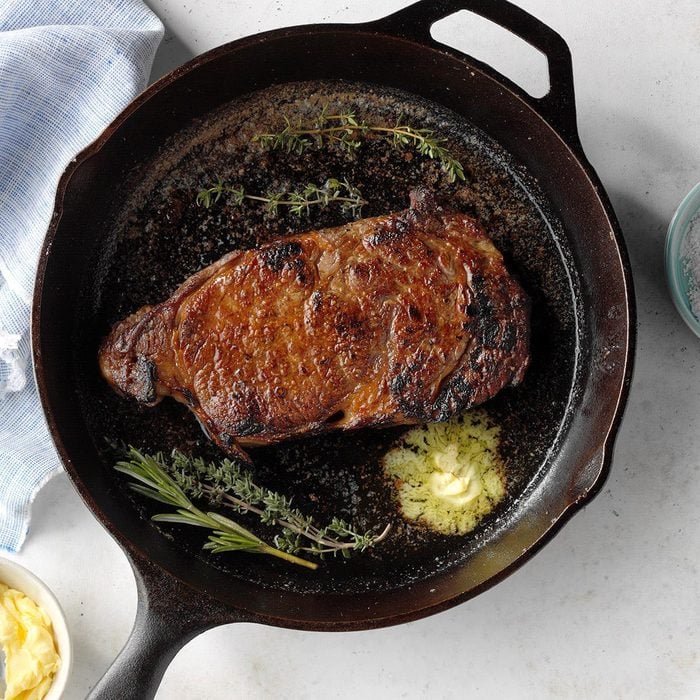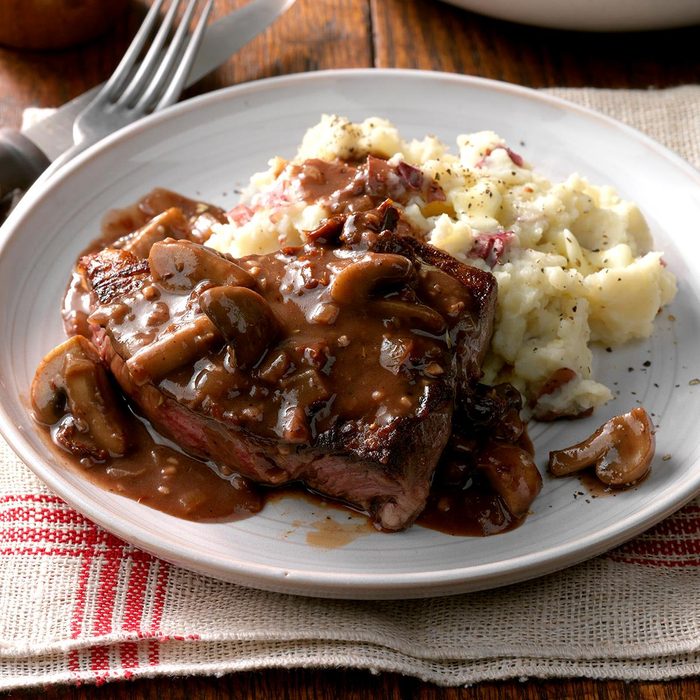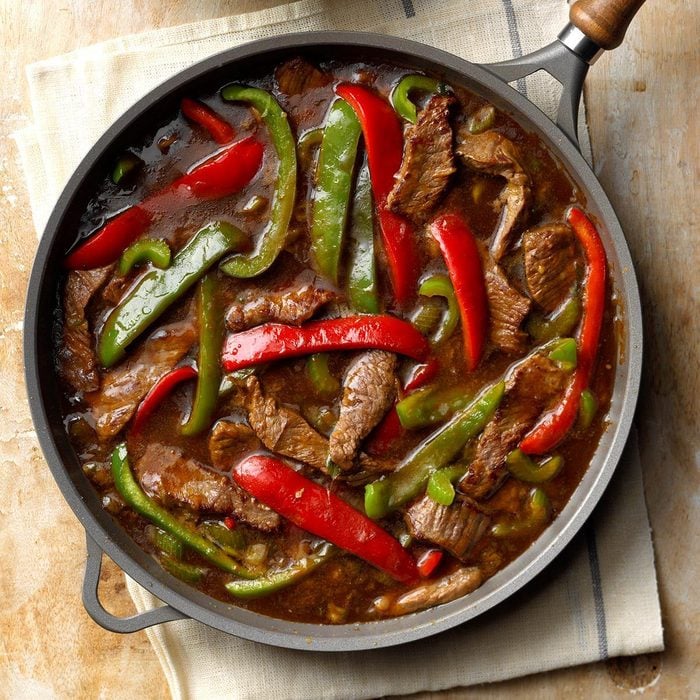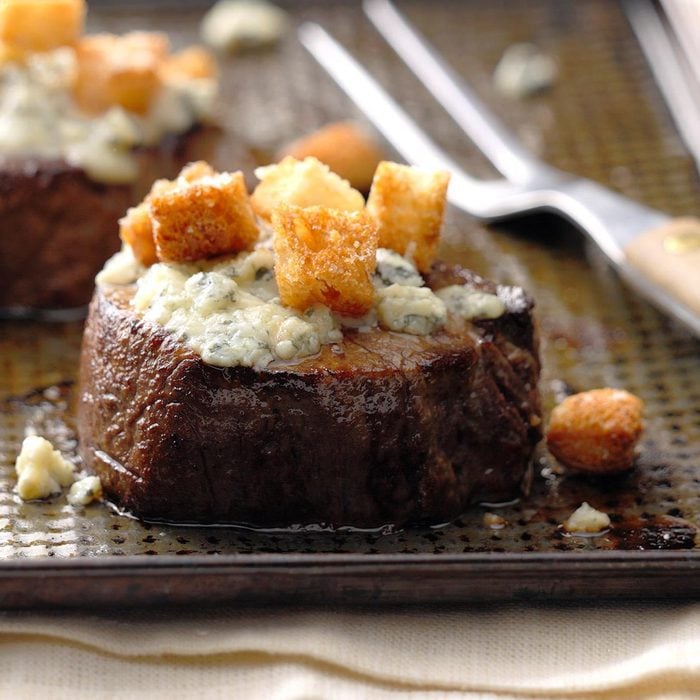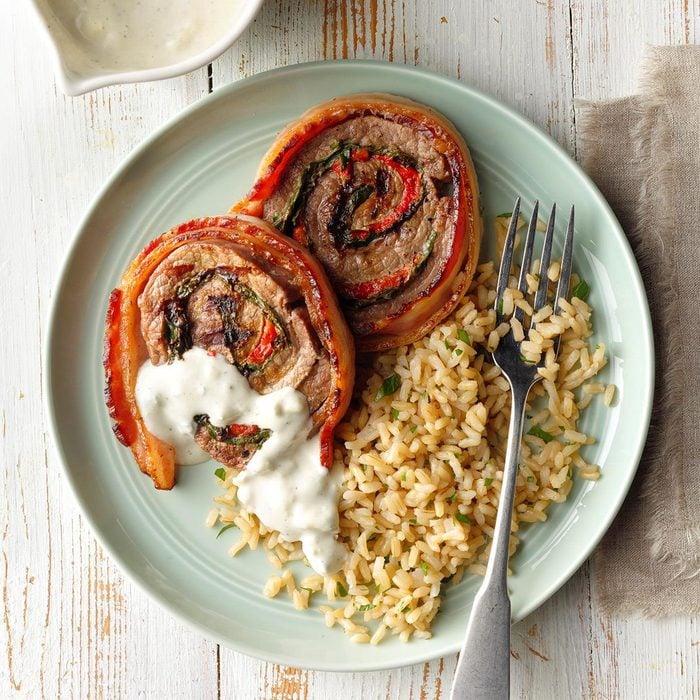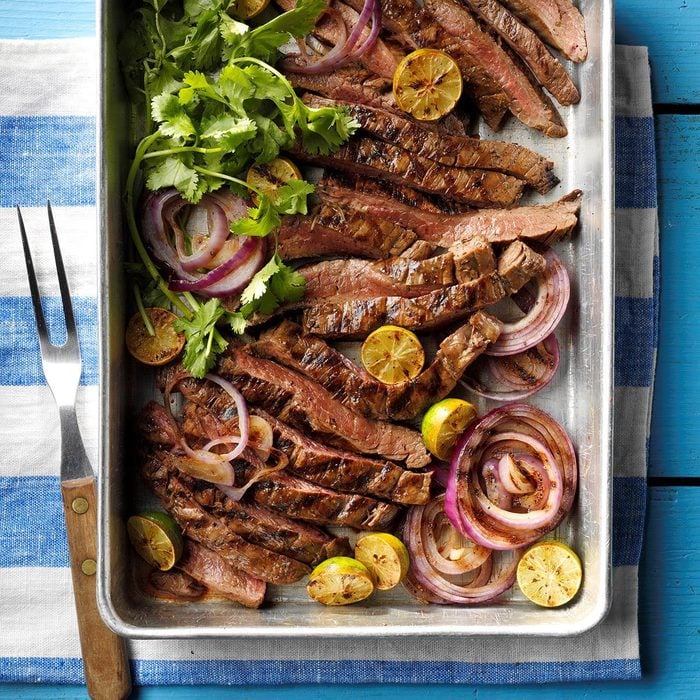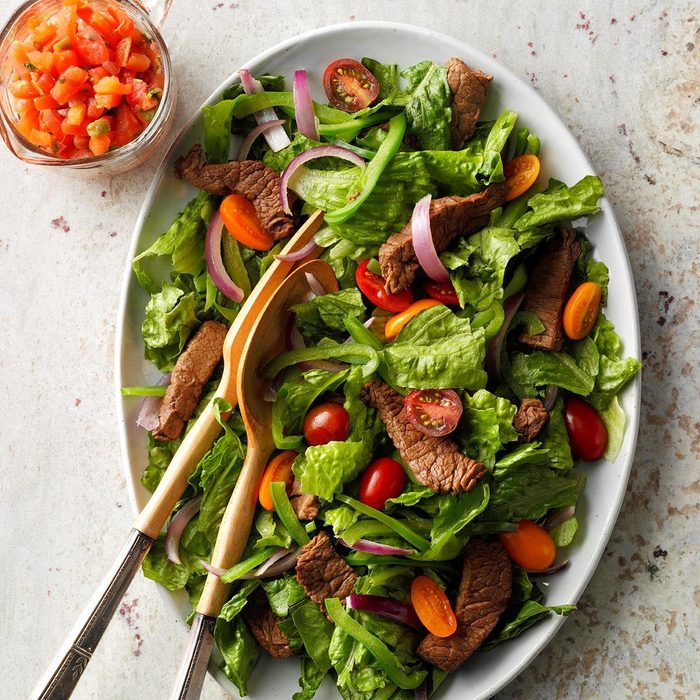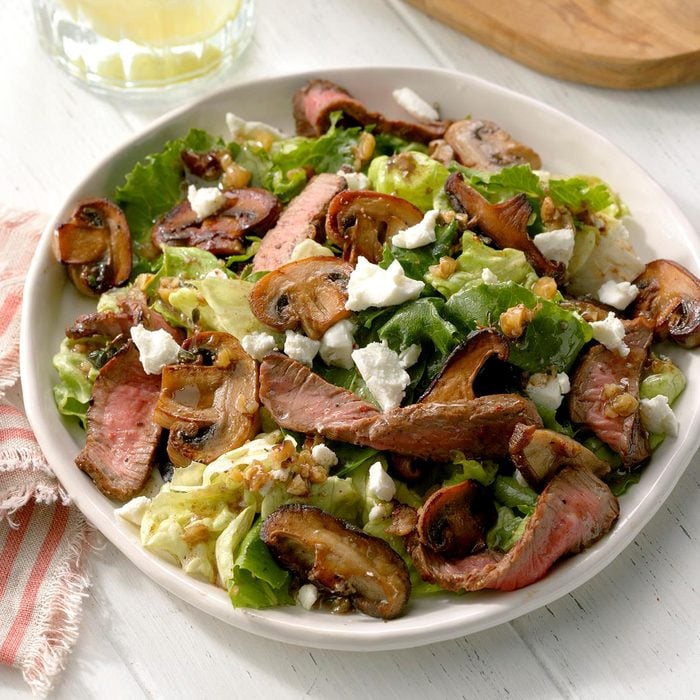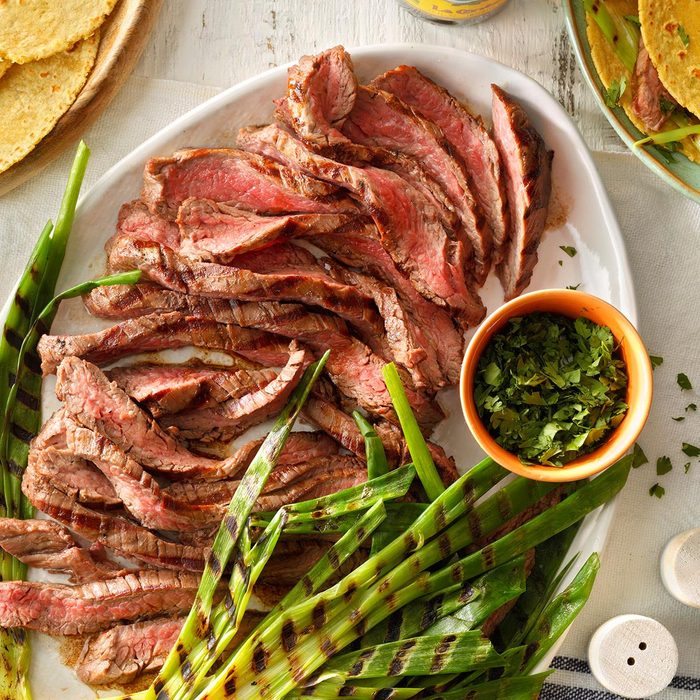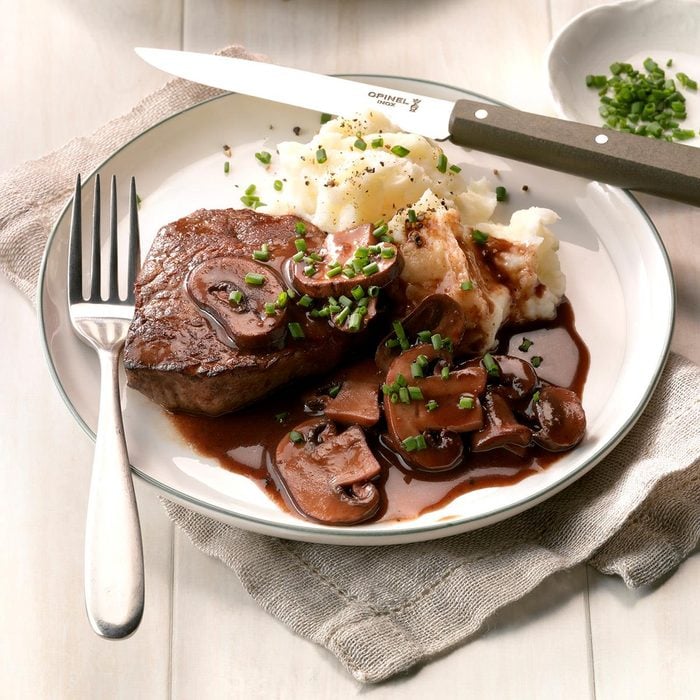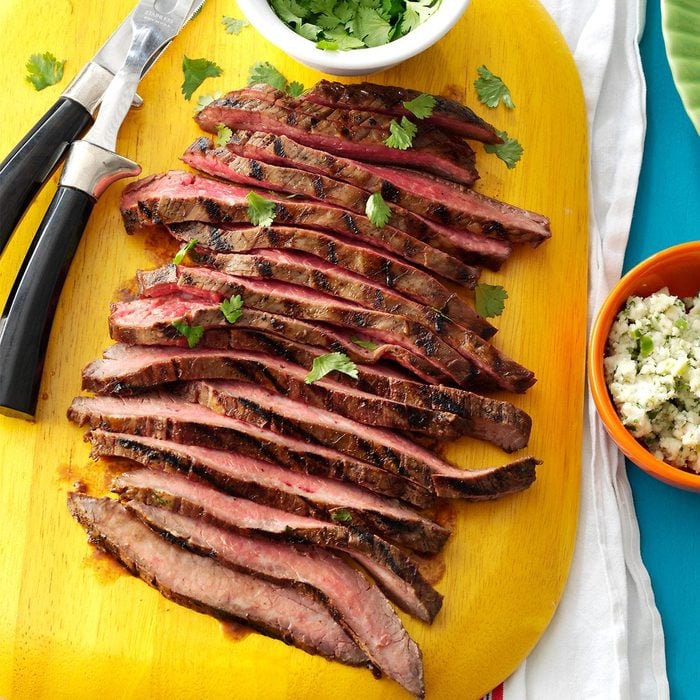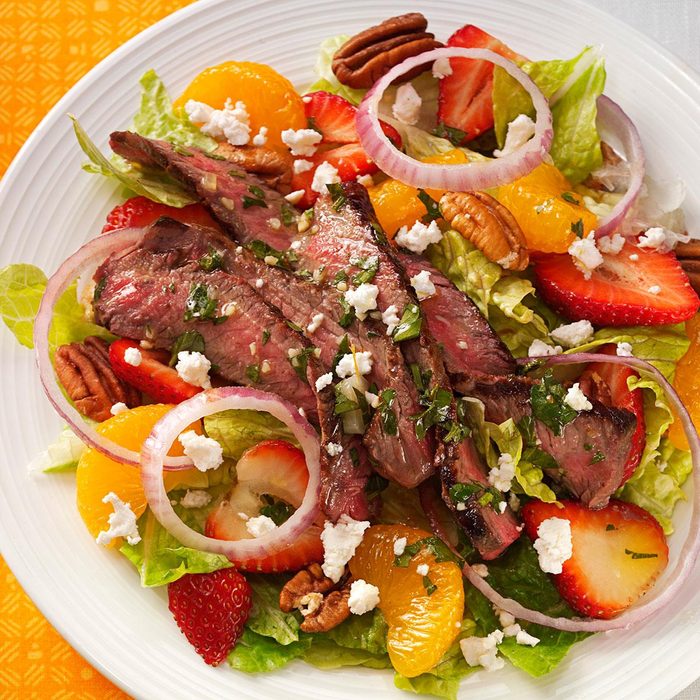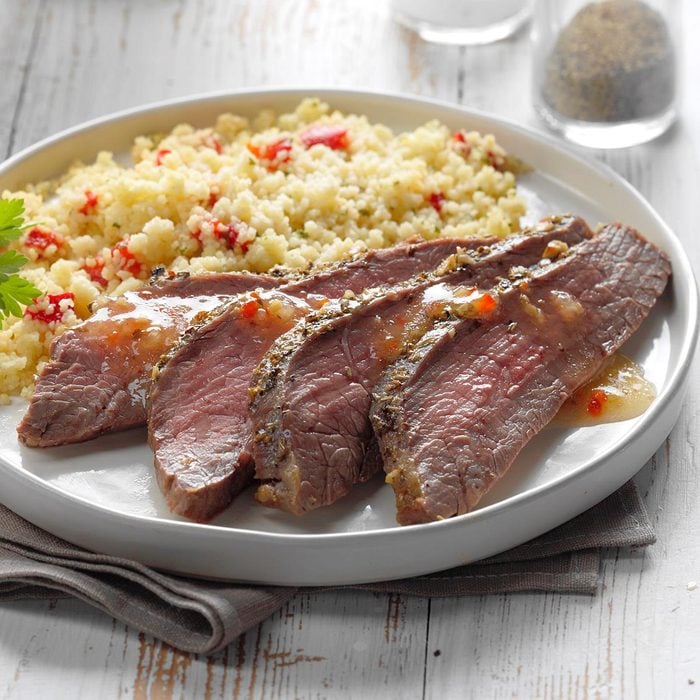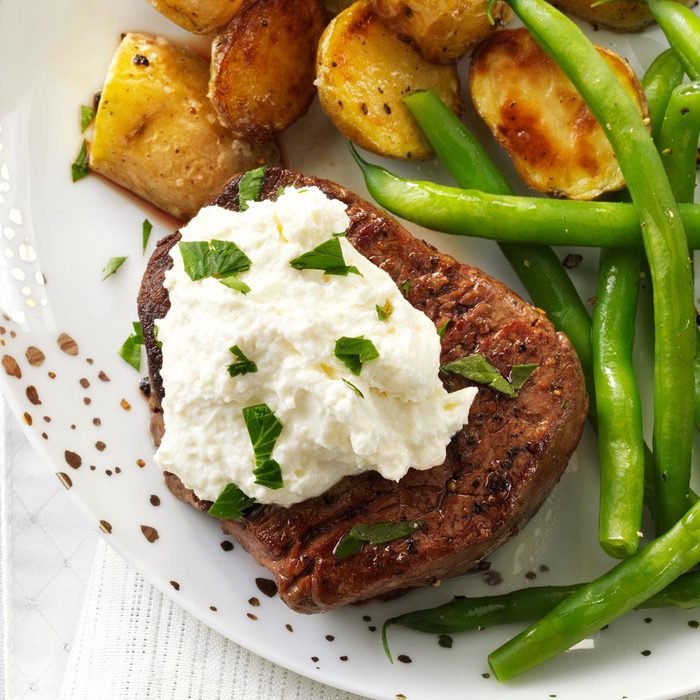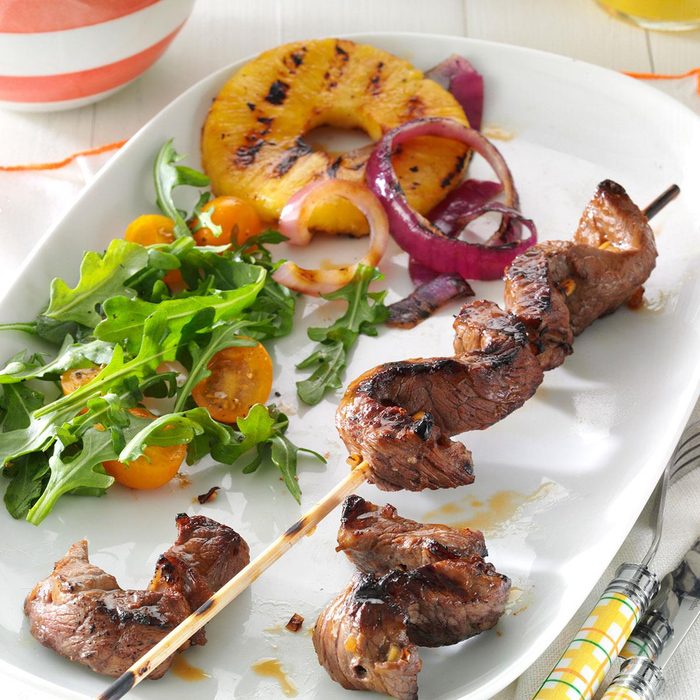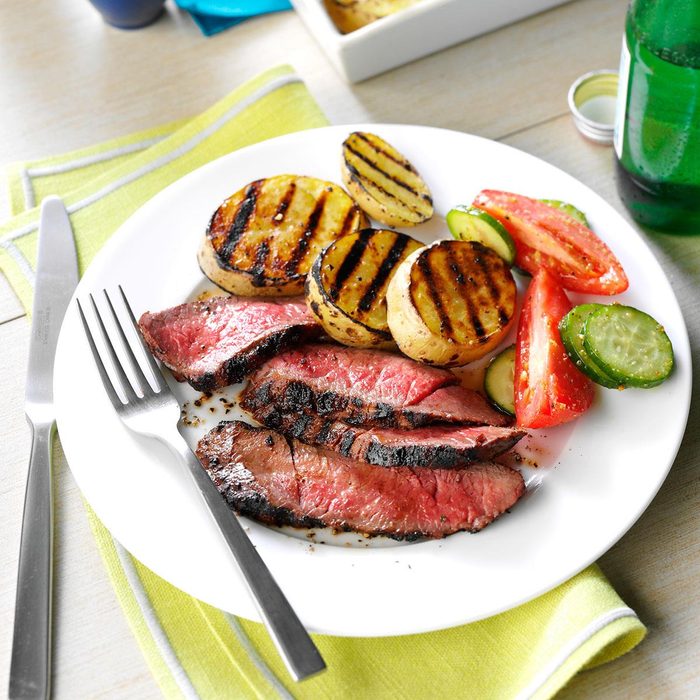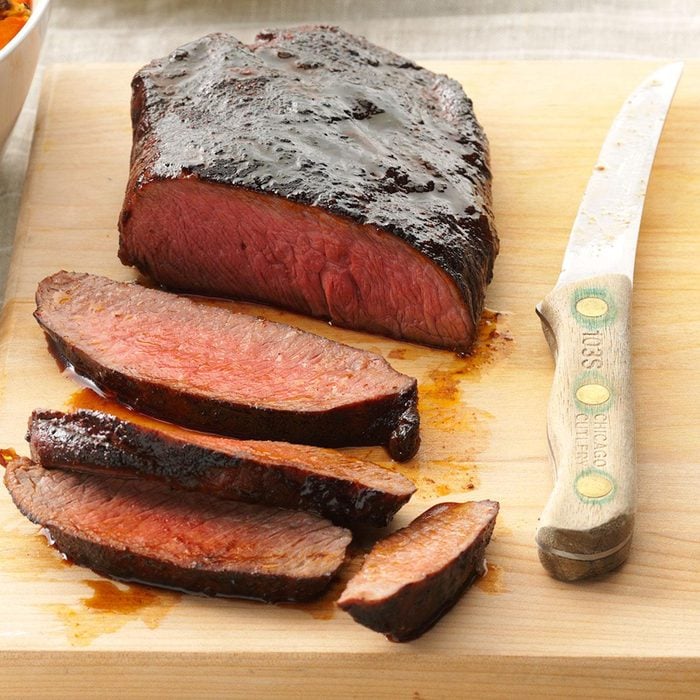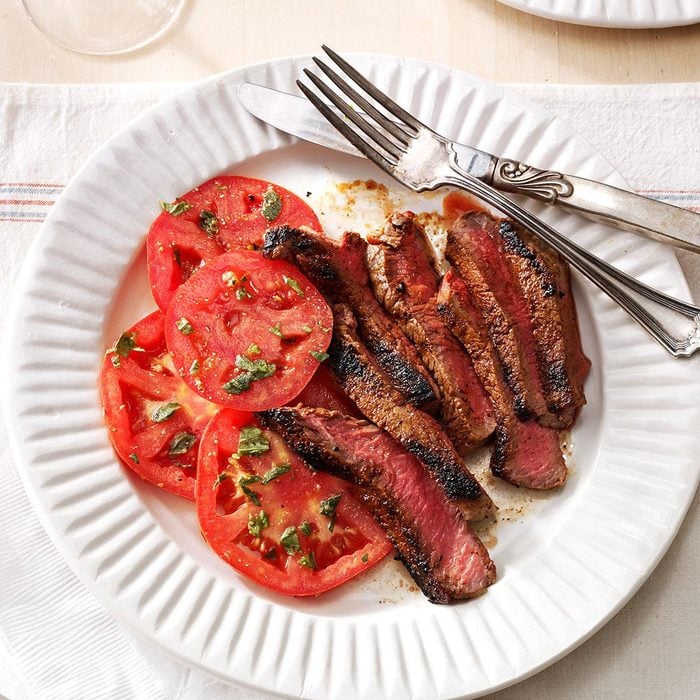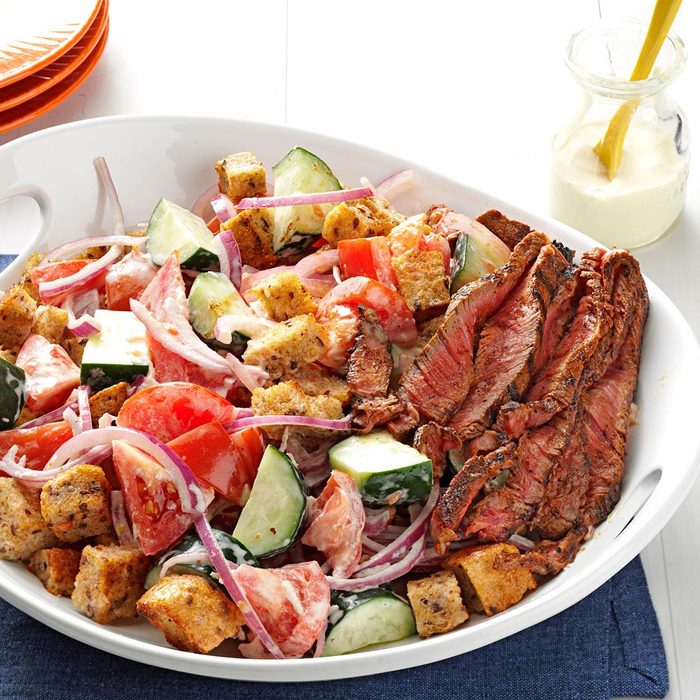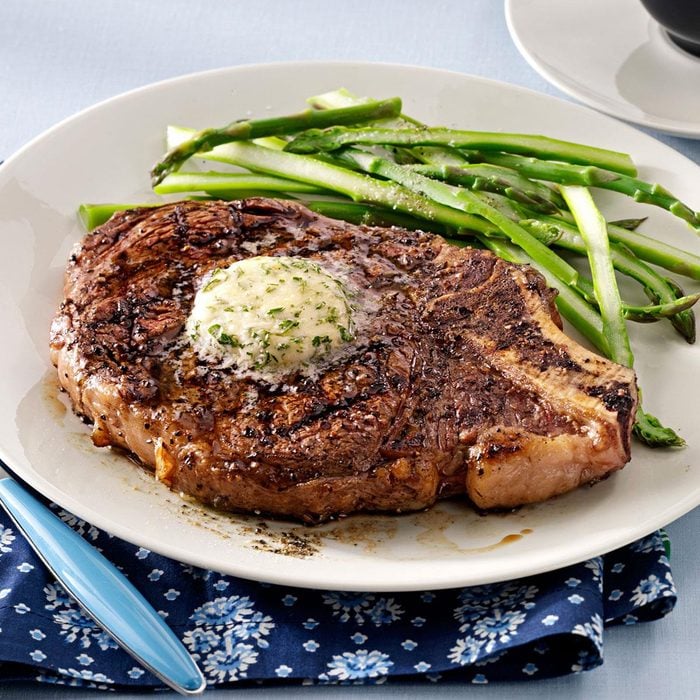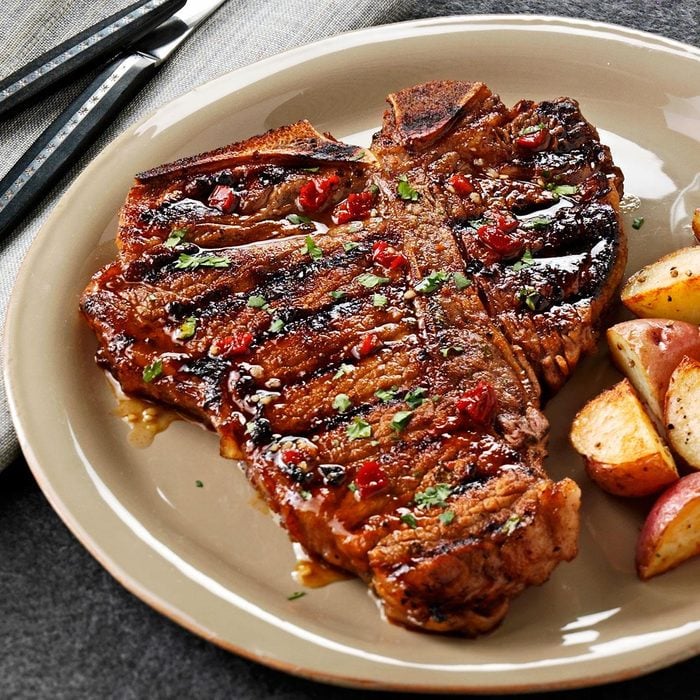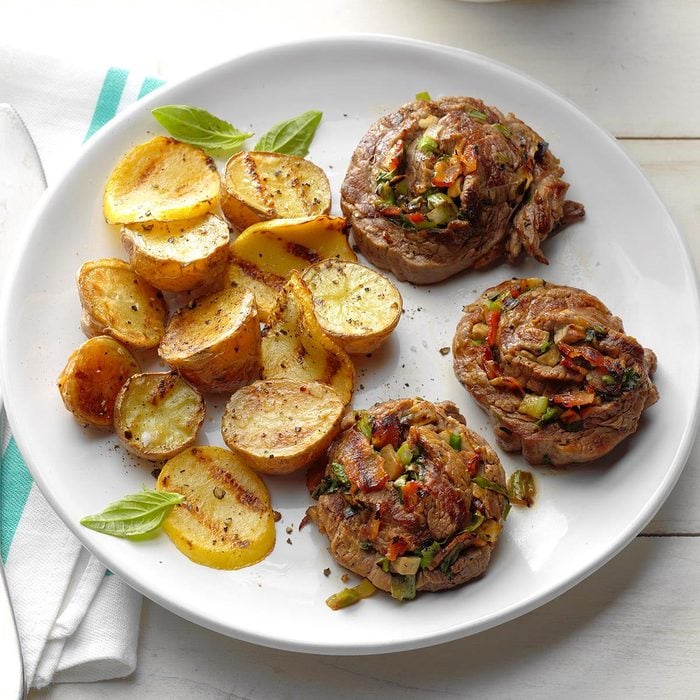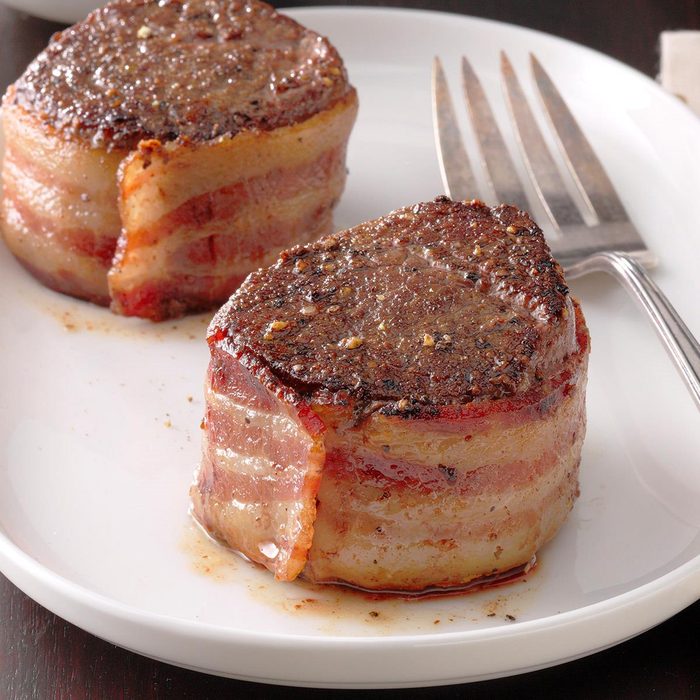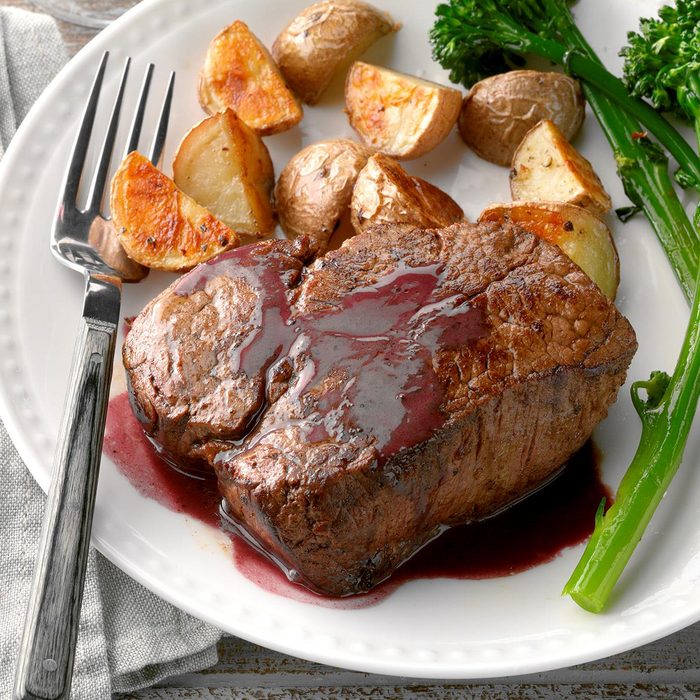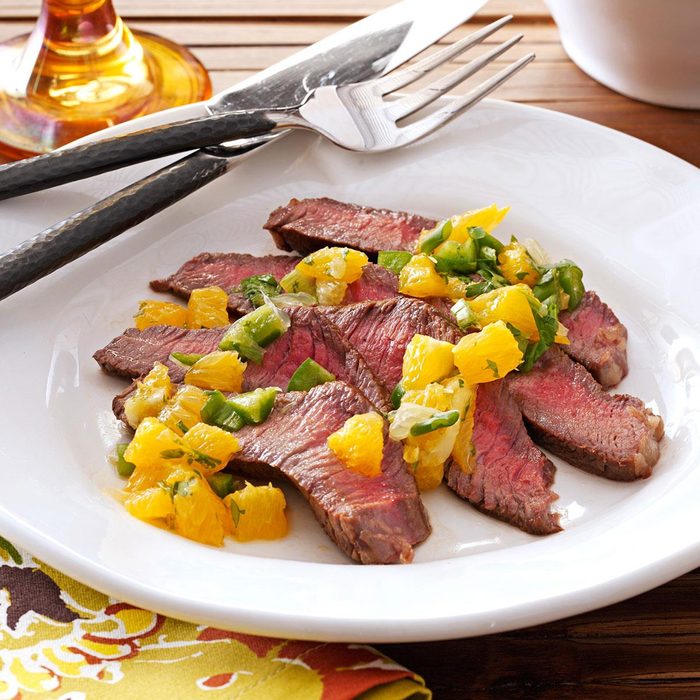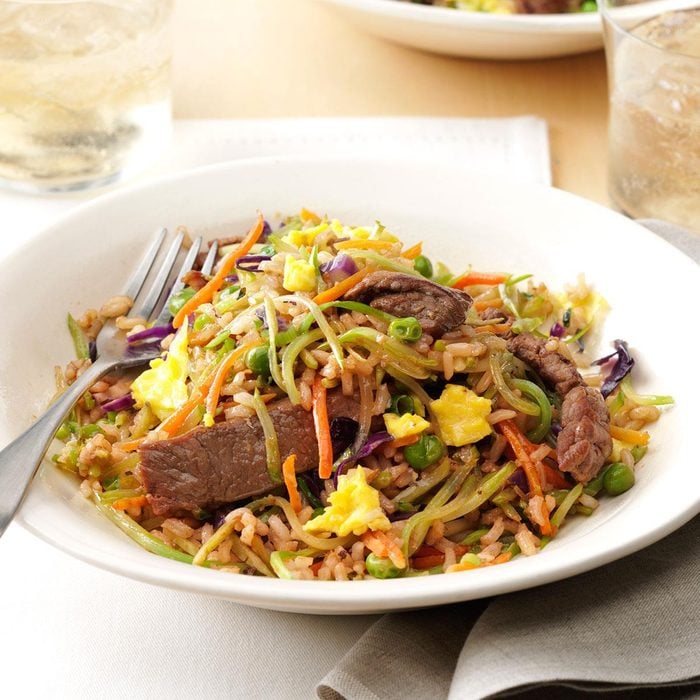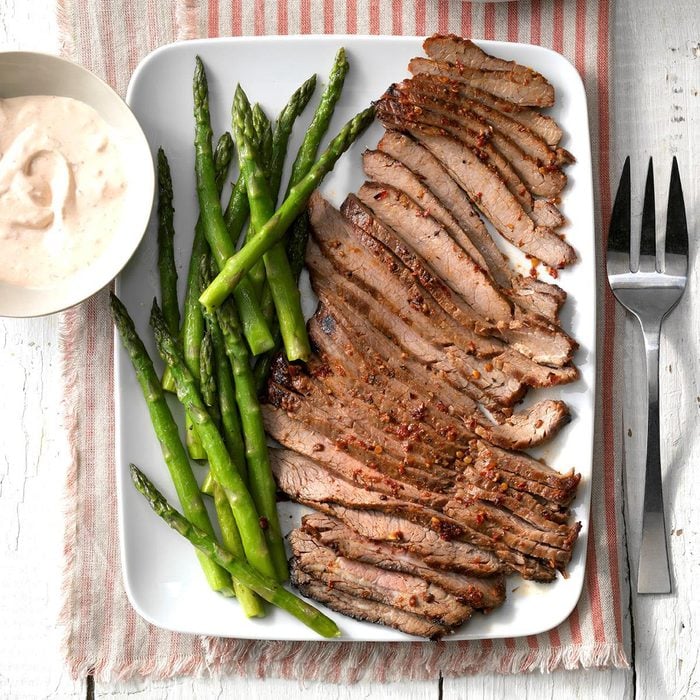There’s nothing quite like a juicy beef fillet to celebrate a birthday, holiday or the end of a long week, and a pepper-crusted ribeye or tender flank steak does just the trick. But if you’re among the home cooks who don’t know how to make steak, have no fear. Many folks who feel quite comfortable in the kitchen otherwise are guilty of cooking dry, tough meat. Read on to avoid the most common mistakes, and get ready to cook the perfect steak every time. By the way, here’s how to how to cook medium-rare steak the right way.
Mistake 1: Not using seasoning
You may be afraid of making steak too salty or overpowering it with spices, but trust us: Caution doesn’t pay when it comes to seasoning. Since you can’t season the steak’s interior, playing it too safe will deprive you of rich flavors and a bold crust.
What to do instead: Season the meat heartily on both sides about 35 to 40 minutes before cooking. For inspiration, check out our favorite DIY spice blends.
Mistake 2: Cooking steak cold
When you’re learning how to cook steak, it’s hard to be patient. But you never want to pull steak straight from the fridge to throw on the grill. Plan ahead, giving the meat time to reach room temperature. A cold steak will cook unevenly, potentially causing the outside to burn while the inside remains undercooked.
What to do instead: Depending on the cut, allow a half-hour to two hours for the meat to sit on the counter. While you’re waiting, keep hunger at bay with some of the appetizers we can’t stop eating.
Mistake 3: Getting the wrong cut
Choosing a steak isn’t as easy as grabbing it from the cooler and heading to the checkout line. There are plenty of varieties, and not all of them should be cooked the same way. For instance, T-bones thrive on the grill, but a boneless ribeye does best in a frying pan (thanks to the fat running through it). Treating all steaks the same can deprive you of the best possible flavor.
What to do instead: Learn your cuts and preferred cooking style. If you forget which cut you like, any good butcher will be happy to provide answers and advice! Want to get more creative with your cut of choice? Grill up our favorite steak recipes.
Mistake 4: Choosing a lean cut
There’s a time and place for lean cuts, but steak night isn’t one of them. Lean cuts tend to be tough and dry, since fat is what provides most of the flavor. (If you’re looking to grill up a lighter meal, draw on your barbecue skills and try grilled honey-lime chicken.)
What to do instead: Pick out a steak with a healthy amount of marbling (the fat which shows up as white flecks and lines). It may be more expensive, but the tenderness and juiciness will be well worth it.
Mistake 5: Turning the steak only once
It’s a common misconception that the best way to keep a steak tender and juicy is to flip it once. While you may get photo-worthy grill marks, your steak won’t be any more delicious. In fact, with this method, you may be drying out the steak.
What to do instead: Get into the habit of turning your steak multiple times as it cooks, especially when the heat is high. Extra flips allow the steak to cook more quickly (up to 30% faster than the one-flip method.) This is what will give you a juicier steak. You’ll also find that this method helps the meat cook evenly, without much curling along the edges.
Test Kitchen tip: It’s essential to use tongs instead of a fork to flip your meat.
Mistake 6: Sticking to the supermarket selection
It makes sense to purchase meat with the rest of your groceries, but if you want to cook a knockout steak, go the extra mile. To cook like a pro, trust a pro to help get you started.
What to do instead: Head to a local butcher. They’ll be able to help you figure out the best cut and introduce you to lesser-known options. A butcher will also be able to answer any cooking questions you have and offer their own suggestions. These are the best cuts of meat you didn’t know you could ask for.
Mistake 7: Cutting into it too soon
A freshly cooked steak is almost too tempting, but resist the urge to dig into it right away. Like lots of other foods, steak needs time to relax, as do the fibers within it. While the meat cooks, its fibers shrink, emitting moisture and making the steak juicy. Cutting into the meat right away will cause that hard-earned moisture to spill out onto the plate, leaving a drier, less flavorful dinner.
What to do instead: Cover the meat in foil and let it rest after cooking—five minutes for thinner cuts and up to 15 minutes for heartier pieces. The fibers will then have time to expand and reabsorb the juices. You can rest while the steak does, or use the time to throw together one of these simple side dishes.
Mistake 8: Skimping on a meat thermometer
No matter how expert your grilling skills, you probably can’t accurately tell when a steak’s ready simply by looking at it. Visual cues can be deceiving: The exterior may look tantalizing while inside is still too raw. If you tend to test how it’s progressing by poking it with a fork, you’re releasing some of those flavors and juices that make the meat delicious.
What to do instead: Wielding a trusty thermometer, aim for internal temperatures of 135 degrees, 140 degrees and 145 degrees for medium-rare, medium and medium-well steaks, respectively. (P.S. If these temperatures are lower than you’re used to, it’s because we’re factoring in a process called “carryover cooking.” Once the steak is removed from the grill, its internal temperature will rise several degrees as it rests. Here’s our whole guide to cooking temps.)
Mistake 9: Using an oil with a low smoke point
Extra virgin olive oil is lauded for its health benefits and for the flavor it adds to sauces and sautes, but when it comes to high-heat situations, leave that bottle in the cupboard. Its smoke point is a relatively low 320 degrees, and it emits unpleasant flavors and toxic chemicals when it passes this point. Because steaks are cooked at temperatures of up to 500 degrees, using dark olive oil risks a smoky kitchen and puts the meat’s flavor at risk, too. (Butter’s smoke point is only 350 degrees, so we’d pass on that, too.)
What to do instead: Generally, lighter oils have higher smoke points. If you plan to brush oil onto your steak, look for peanut, canola or extra light olive oil, or check out our guide to cooking oil of all kinds.
Mistake 10: Not cleaning the grill
There’s nothing quite so tedious as cleaning a grill, but a dirty grill makes for subpar steak. Debris on the grate makes it sticky and causes the meat to adhere and tear. You’ve worked hard-don’t let a little neglect stand in the way of cooking a perfect steak.
What to do instead: Clean the grill each time you use it. When the coals are still hot, use a wire brush to clear gunk off the grates. Top it with a small amount of oil, and the grill will be good for the next use. Armed with a clean grill, don’t be afraid to get creative: Try out dozens of unexpected recipes you can (and should) grill.
Have leftovers? Learn how to repurpose last night’s dinner into one of these amazing leftover steak recipes.
Up Next: 16 Types of Steak Everyone Should Know
Our Juiciest Steak Recipes
Tenderloin Steak DianeFor this classic skillet steak dinner, just sear the steaks in butter and top with a gorgeously silky mushroom cream sauce. It’s elegant and effortless all at once.
Cast-Iron Skillet SteakYou definitely don’t have to keep steak for special occasions. One of the easiest ways to cook it is seared in a cast-iron skillet with or without butter. All you need after that is a nice
leafy salad to complete the meal.
Psst! If you love steak, you need this
custom branding iron for grilled meats.
Steak with Chipotle-Lime ChimichurriChimichurri is a piquant herb sauce that complements steak perfectly. Once you learn how to make the sauce, you'll want to serve it all summer long.
Steaks with Mushroom SauceBy using top sirloin, this dish is great for a weeknight dinner for two or four. The rich mushroom-wine sauce brings out the best of the beef-forward flavor, and it tastes great with sides like roasted potatoes and green beans.
Quick Pepper SteakWith a simple sweet and savory sauce, sliced sirloin and fresh bell peppers, this skillet supper comes together in a flash. Serve it with steamed white, brown or cauliflower rice for a fuller meal.
Beef Steaks with Blue CheeseBroil, grill or quickly sear these steaks in a cast-iron pan to get a nice caramelized crust on the outside while keeping the meat tender inside. The size of the steaks, blue cheese topping and croutons can easily be cut in half for smaller portion sizes.
Flank Steak PinwheelsButterfly and flatten a flank steak so there’s a large surface area for this savory red pepper and spinach stuffing. Roll it up, wrap in bacon (yes!) and grill for a few minutes. Once sliced, serve with a delicious creamy blue cheese sauce.
Key West Flank SteakFlank steak is great for the grill, especially with this lime and garlic marinade, and it cooks quickly, just a few minutes per side. After letting it rest, slice against the grain. Need more ideas for this economical cut of beef? Check out some of our other
flank steak recipes.
Zesty Steak SaladCook marinated top sirloin steak for this zesty salad, or feel free to use leftover steak from another meal. While the base is leafy romaine lettuce, add anything else you love to the bowl, from cucumbers and mushrooms to cheese.
Air-Fryer Steak FajitasOf course you can make steak in the air fryer! This marinated flank steak takes less than 10 minutes. While you let it rest, slice avocado, onion and lime wedges for serving.
Mushroom Steak Salad with Walnut VinaigretteThis steak salad is a great date night steak recipe because it’s impressive but easy to throw together for any night of the week. Serve with some crusty bread and a great bottle of wine.
Grilled Onion & Skirt Steak TacosSkirt steak is usually a pretty tough cut with lots of connective tissue. That’s why you want to use something like this beer and lime marinade to tenderize it and add flavor. Like other
grilled steak recipes, a quick sear over the fire is all it takes.
Beef Filets with Portobello SauceThese steaks with a rich and savory portobello mushroom sauce are a perfect meal for two. Complete the meal with zesty potatoes, a leafy salad and a hunk of great bread.
Flank Steak with Cilantro & Blue Cheese ButterOnce you learn a great
steak marinade recipe, you’ll be able to turn even the toughest cut of meat into a delicious dinner. This sweet citrus marinade transforms flank steak into a tender flavorful cut.
Garlic Grilled SteaksElevate your grilled strip or ribeye steaks with this amazing garlic mixture. Have extra? Learn how to repurpose last night’s dinner into one of these amazing
leftover steak recipes.
Citrus Steak SaladThere are so many wonderful flavors in this salad, thanks to fresh greens, mandarin oranges, strawberries and a citrusy vinaigrette. The only thing you need to cook is the steak, and dinner is on the table in no time.
Flank Steak with CouscousFor this recipe, use sirloin steak if you prefer it over flank steak. Both take only minutes to broil and have lots of beefy flavor. Make sure to cut against the grain for the most tender pieces.
Tenderloin with Horseradish Cream CheeseThe sharp peppery flavor of horseradish has always been a great foil for a rich, juicy steak. Blend it with cream cheese, parmesan and parsley for a delicious steak topper, and serve with a classic baked potato.
Teriyaki Steak SkewersThese teriyaki steak skewers will be the hit of your next backyard barbecue. The aroma alone will get everyone’s attention, but once they taste the sweet and savory marinade, they’ll be hooked. You can easily double or triple this recipe for a crowd.
Southwest Steak & PotatoesMake this whole meal on the grill for your next cookout. The steak gets a brush of vinegar and Worcestershire before a rub of zesty spices, and the potatoes taste great with a little char from the fire.
Maple & Blue Cheese SteakA marinade of balsamic vinegar, maple syrup and Dijon adds a ton of flavor to this steak, and it complements the sharp blue cheese topping. Any cut that you’d grill works here, including sirloin, strip or ribeye.
Smoky Espresso SteakWith espresso, cocoa and pumpkin pie spice, it may sound like you’re making dessert, but it’s actually a delicious rub that transforms broiled or grilled flat iron steak into a flavor bomb.
Grilled Steaks with Marinated TomatoesTalk about peak summer. Sometimes all you need for a perfectly grilled steak is a side of fresh garden tomatoes marinated in raspberry vinaigrette and fresh herbs and spices. A side of cheesy potatoes or sauteed green beans work, too!
Garlic-Rubbed T-Bones with Burgundy MushroomsPorterhouse or T-bone steaks are great on the grill, especially when rubbed with garlic and served with wine-soaked mushrooms. Take dinner to another level with
creamy twice-baked potatoes and a Caesar salad.
Chili-Rubbed Steak & Bread SaladThe chili-rubbed grilled steak and fresh vegetables make this panzanella-like salad a one-bowl meal. Use thick-cut bread for the cubes so they can soak up all the flavors.
Grilled Ribeyes with Herb ButterWith Dijon and herbs de Provence, this full-flavored marinade practically takes you to the French countryside. After the steaks come off the grill, top with a savory herb butter. For something more American, try our new obsession:
cowboy butter.
Chipotle-Honey Grilled T-BonesFor all the heat lovers out there, these T-bones have a spicy kick. Great on the grill or seared indoors, make these the centerpiece of a Tex Mex-inspired dinner.
Peppered Ribeye SteaksThis peppery DIY steak rub brings out all the beefy flavor of grilled ribeye steaks. Pair it with a
sweet corn and tomato salad for a perfect summer meal.
Grilled Steak PinwheelsEasy to prepare, steak pinwheels make a statement, especially with this savory mushroom filling. It’s a great summertime option when the grill (and the days and nights) are hot and you want to keep the kitchen cool.
Bacon-Wrapped Filets with Scotched MushroomsYou’ve seen the bacon-wrapped filet mignon at the grocery store, but it’s just as easy to make at home. This recipe is perfect for two (yay, date night!), but it can easily be doubled or tripled for a dinner party.
Merlot Filet MignonRemember: when you’re cooking with wine, don’t use the cheap stuff; cook with one you’d like to drink. It makes all the difference in a buttery wine sauce like this.
Chocolate-Chipotle Sirloin SteakCocoa powder won’t make your steak sweet. Unsweetened chocolate adds depth and color to steak. It’s also a perfect complement to smoky chipotle peppers. Here are some other surprising
ingredients that take your steak from good to great.
Steak with Citrus SalsaIn the summer, this lime marinade perks up grilled steaks. In the winter, broiled or pan-seared steaks get a blast of sunshine from citrus salsa.
Ginger Steak Fried RiceTurn leftover rice and steak into a quick fried rice. Broccoli slaw mix and frozen peas make it an easy-peasy weeknight meal.
Spicy Flank SteakSpice up a flank steak with red pepper flakes and chili powder, and then serve with a cool sour cream sauce. If you prefer, grill the steak over medium-high heat rather than broiling.























